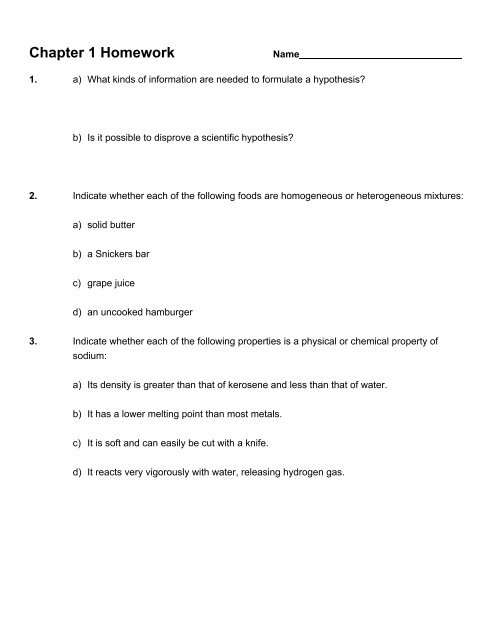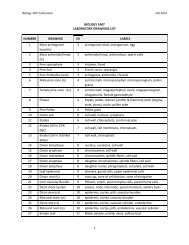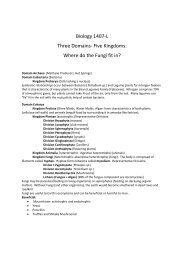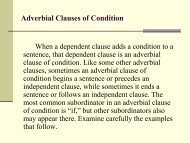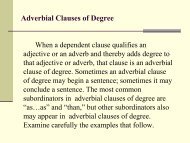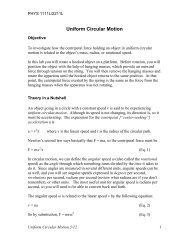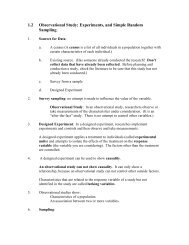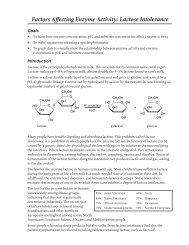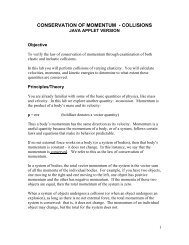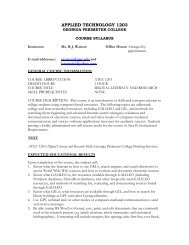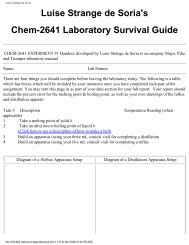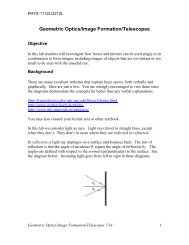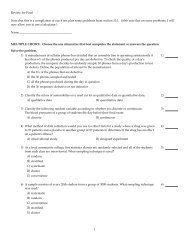Chapter 1 Homework
Chapter 1 Homework
Chapter 1 Homework
Create successful ePaper yourself
Turn your PDF publications into a flip-book with our unique Google optimized e-Paper software.
<strong>Chapter</strong> 1 <strong>Homework</strong><br />
Name<br />
1. a) What kinds of information are needed to formulate a hypothesis<br />
b) Is it possible to disprove a scientific hypothesis<br />
2. Indicate whether each of the following foods are homogeneous or heterogeneous mixtures:<br />
a) solid butter<br />
b) a Snickers bar<br />
c) grape juice<br />
d) an uncooked hamburger<br />
3. Indicate whether each of the following properties is a physical or chemical property of<br />
sodium:<br />
a) Its density is greater than that of kerosene and less than that of water.<br />
b) It has a lower melting point than most metals.<br />
c) It is soft and can easily be cut with a knife.<br />
d) It reacts very vigorously with water, releasing hydrogen gas.
4. How many significant figures are in each of the following measurements<br />
a) 35.0445 g<br />
b) 0.00450 m<br />
c) 0.03050 L<br />
Note:<br />
from this point on, all your answers must have the correct number of significant<br />
figures! Make sure you round off correctly too.<br />
5. Round off the following quantities to the number of significant figures indicated in<br />
parentheses (don’t forget to put the unit of measurement after the number):<br />
a) 7.0001 kg (4)<br />
b) 2.30985 x 10 –4 m (5)<br />
c) 68.507 cm (2)<br />
d) 4.995 x 10 3 mL (3)<br />
6. Do the following calculations and use the correct number of significant figures in your<br />
answer. Assume all numbers are the results of measurements (i.e. none of the numbers<br />
are constants).<br />
a)<br />
( 8.71) 0.0301<br />
0.031<br />
( )<br />
b) ( 2.25!10 –3<br />
)( 8.754 !10 6<br />
)<br />
c) 8.937 !8.930<br />
d) 847.89 !847.73+ 2.5
7. The Eiffel Tower in Paris is 324 m tall, including a 24 m television antenna that was not<br />
there when the tower was built in 1889. What is the overall height of the Eiffel Tower in<br />
kilometers<br />
8. Diamonds are measured in carats, where 1 carat = 0.200 g. The density of diamond is<br />
3.51 g/cm 3 . What is the volume of a 5.0 carat diamond<br />
9. What is the mass of 65.0 mL of ethanol if its density at room temperature is 0.789 g/mL<br />
10. Ethyl chloride acts as a mild topical anesthetic because it chills the skin when sprayed on it.<br />
It dulls the pain of injury and is sometimes used to make removing splinters easier. The<br />
boiling point of ethyl chloride is 12.3°C. What is its boiling point on the Fahrenheit and<br />
Kelvin scales<br />
Bonus.<br />
At what temperature do the Fahrenheit and Celsius scales have the same numerical value<br />
Show your work to receive credit.
11. Three different analytical techniques were used to determine the quantity of sodium in a<br />
Mars Milky Way candy bar. Each technique was used to analyze five portions of the same<br />
candy bar, with the following results (expressed as milligrams of sodium per candy bar):<br />
mg of Na:<br />
Technique 1<br />
mg of Na:<br />
Technique 2<br />
mg of Na:<br />
Technique 3<br />
109 110 114<br />
111 115 115<br />
110 120 116<br />
109 116 115<br />
110 113 115<br />
The actual quantity of sodium in the candy bar was 115 mg.<br />
a) Which of the techniques are precise<br />
b) Which of the techniques are accurate<br />
c) Which of the techniques are both precise and accurate<br />
12. Sodium metal reacts vigorously with water. A piece of sodium weighing 19.70 g was added<br />
to a beaker containing 126.22 g of water. During the reaction, hydrogen gas was produced<br />
and bubbled from the solution. The solution, containing sodium hydroxide, weighed<br />
145.06 g. How many grams of hydrogen gas were produced<br />
13. A gallon of ice cream contains exactly 32 servings, and each serving has 165 Calories, of<br />
which 30.0% are derived from fat. How many Calories derived from fat would you consume<br />
if you ate one-half gallon of ice cream
14. When a teacher gave a “pop quiz,” 18 of the 24 students in the class passed the test. What<br />
percentage of the class did not pass the test<br />
Bonus.<br />
A 33.0 g sample of an unknown liquid at 20.0°C is heated to 122°C. During this heating, the<br />
density of the liquid changes from 0.854 g/mL to 0.797 g/mL. What volume would this<br />
sample occupy at 122°C


